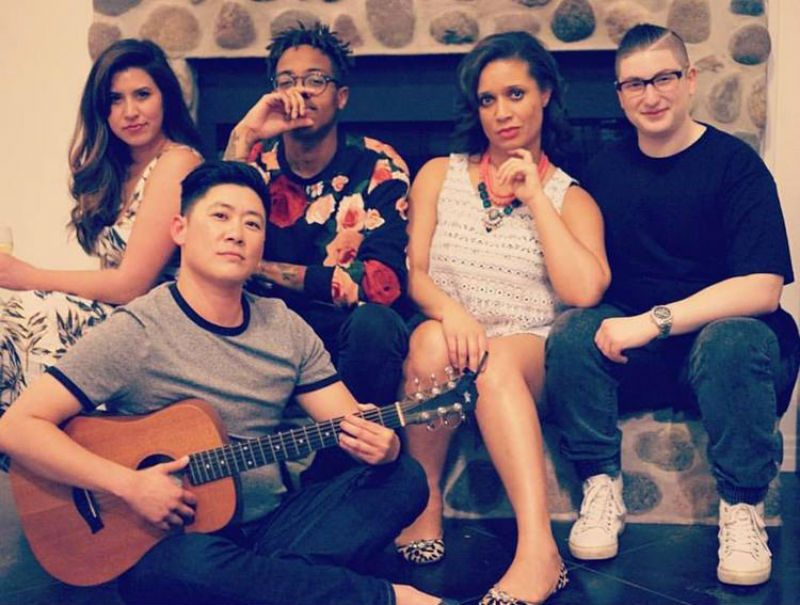SXSW panels on clothing and brand marketing usher in authenticity in fashion.
Like most closeted teenagers, I thought Halloween was the greatest mainly because I could wear absolutely anything I wanted and get away with it since those gender non-conforming clothes were “just a costume.”
But I came out and grew up, and now I’m an urban professional facing the daily conundrum of what to wear. Like many lesbians who prefer to dress a bit dapper, sometimes the clothes I feel best in are off-putting to others. The older I get, the more I understand: queer style is a matter of visual activism.
Anita Dolce Vita also understands this, which is why she assembled the first ever queer style panel for South by Southwest (sxsw.com) on the 30th anniversary of this cutting-edge cross-disciplinary festival. I went down to Austin, Texas, last week to check it out. Panelists included Anita Dolce Vita of dapperQ; Sonny Oram of Qwear; Leon Wu of Sharpe Suiting, and Aja Aguirre of Fit for a Femme. About fifty people attended this diverse panel of queer fashion interests, and the audience was equally full of suits and skirts. Everyone was jazzed to get in a room with others who understand that, as Anita said in her introduction, “fashion is political.”
She began with footage from dapperQ’s recent New York fashion show (video here), and followed up with a slideshow (here) to give some historical context for socially-charged gender presentation in clothing, including trends like flapper dresses in the 20s and sagging jeans in the 90s. Her goals for the panel was to see “the audience walking away with a solid definition of queer style as an evolving aesthetic and learning approaches to making the industry more diverse, culturally competent, and just.”
On the question of defining queer style, Oram posed the key question: “When a queer gets dressed, there’s the tension between what I’m expected to wear versus what I want to wear. How do you align with the stereotypes?” Aguirre declared that style “is an opportunity to express your identity”, and Wu went further to call it “a social movement” from “urban swag to dapper luxury.” He pointed to the increasing volume of female and trans voices in this conversation, whereas many people perceive fashion as driven exclusively by gay men.
This points to the secondary question of why masculinity or androgyny have been long held as the gold standard of queer style. Aguirre speculated on the transgressive nature of femme fashion, arguing that “when you’re a queer woman—when you’re a trans woman—femininity comes at a cost”. Dolce Vita agreed that “femme style is about reclaiming and redefining femininity”. Wu discussed his past work as a drag king, and as the only designer on the panel, set himself a high bar indeed: “I want to influence [social and political] change through commerce.”
Oram had by far the best sense of humor about the ultimate mission of the panel and the most thorough philosophy of openness to whatever the future may hold: “The goal is to dismantle the definition of ‘queer style’, to help the community see each other”. This was a panel by queers and for queers, but in other corners of SXSW, the same conversation was taking place amongst corporations of all kinds, with a different vocabulary centered on LGBTQ people as a target audience and the profitability of social change as a kind of brand strategy.
In a panel titled “The New Marketing of Brands: Body Image and Gender”, Meredith Walker, who co-founded Smart Girls with Amy Poehler, said that girls “want to be considered human beings and not dismissed because of their youth. They want authenticity.” Jess Weiner, who consulted with Mattel on Barbie’s new body types, said corporations need to get better at avoiding the trap of “sounds fabulous, says nothing.” Walker encouraged women to “change the world by being yourself. There’s a lot of advertising and marketing out there that says ‘don’t be yourself’.”
These messages ring true especially for an LGBTQ audience, and the panel “When #LoveWins: How to Sustain a Viral Movement” was even more explicit about that. Eli Pariser, the CEO of Upworthy, said, “the real measure of success isn’t views; it’s what do you remember a month later, two months later? What sticks with you?” What sticks with us is where we end up spending our money. He concluded, “there’s a moment when people decide to stand up publicly behind a story,” and that’s when real social change occurs.

Moderating a panel on “Heads and Hearts: Consumer Engagement Where it Counts,” Christina Binkley, Fashion Editor for the Wall Street Journal, very much agreed that “authenticity” is a concept whose time has come. She looped in a neuroscientist and the Director of Brand Strategy at Cadillac to make clear that in the most updated science of sales, tribes have a profound social effect.
As a tribe, LGBTQ people do not want to be treated as a “target audience”, we want to be offered a mindset that is worth encouraging. There is rational brand loyalty and there is emotional brand loyalty, and LGBTQ individuals should insist on both.
We want to dress in a way that feels authentic to us—in a way that delivers us into a state of more consistent self-confidence in the workplace and on the weekends. Whatever type of clothing we feel belongs in each of our individual closets, it should express our true, queer selves. Our style should bring us joy, and with this self-respect we will increasingly garner the respect of others.
That respect is the social acceptance upon which our freedom and equality are predicated. It turns out: that gorgeous daffodil-colored polka-dot bow tie you’ve been too nervous to wear with that perfect little black sun dress really is a statement piece in more ways than one.
So when you get dressed, do as Weiner urged her panel’s audience and “be as unafraid as you can.”
